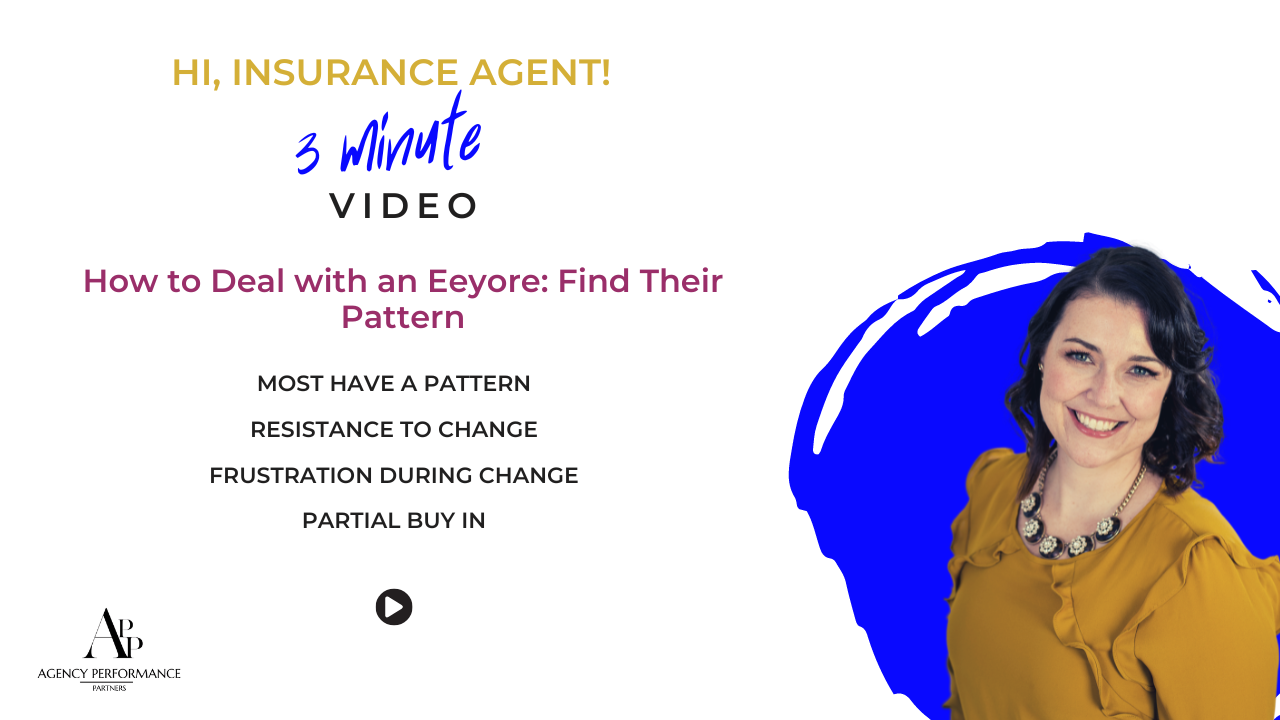How to Deal with an Eeyore: Find Their Pattern
All this week we’ve been talking about Eeyores in your insurance agency, and how exactly you should deal with them. So far, we spoke about how to tell who exactly is an Eeyore in your agency, and if you can change an Eeyore or not. Today, we were diving into the topic of finding your Eeyore’s pattern, and using them in your favor.
“When you know a pattern of an Eeyore, you can expect it. So if you know that they’re particularly resistant to change, you can invite them to understand change a bit earlier. You can also fully know that they’re going to not be excited about change, and just keep moving forward.”
Before we get into it, let’s backtrack a little bit. What exactly is an Eeyore in your insurance agency? If you think back to your childhood and remember the cartoon Winnie the Pooh, then you’ll remember his beloved friends Eeyore and Tigger. Tigger was the bouncing, bounding tiger, while Eeyore was the slow, pessimistic, and downtrodden donkey.
Well, just like Pooh had his Tigger and his Eeyore, it’s very likely that in your agency, you have these characters as well. Your Tiggers are enthusiastic, energetic, and bounce into action. They’re excitable, and are willing to jump into just about anything. On the other hand, your Eeyores are slower, might be more pessimistic or concerned about things, and are probably anxious around change. Even good news can get Eeyores worried.
But Eeyores have their strengths. There are times when their slow and steady nature can be useful, and they can be a good balance for a lot of Tigger energy. But you have to understand your Eeyores, and if they’re a good fit for your agency, figure out how to maximize their potential and skills.
So, we’ve already spoken about how to figure out who your Eeyores are, and how you should look to play to their strengths, instead of trying to force them to change. But did you know Eeyores also have habits? Understanding those patterns can help you understand them, and also find ways to work with them in a productive and useful way.
Identifying the Eeyore Pattern
Everyone has a pattern, and that includes Eeyores. Just like some people are morning people, some people like to take walks during their lunch break, Eeyores too have patterns. And your first instinct as a leader might be to try to change an Eeyore, in order to “fix” the situation. But instead, you should be looking to identify their pattern.
Think about it this way: if you’re a problem-solver, and you’re in a relationship with a person who just needs to vent, you’re not going to try to solve all of that person’s problems when they’re upset. No, instead, you’ll probably just be a listening ear, and will turn off the “problem solving” portion of your brain when they come to you with an issue.
Likewise, if you know the pattern of an Eeyore, you can expect it, and shift your response appropriately. So if you know they’re particularly resistant to change, you can invite them to understand the change a bit earlier. You can also understand they’re probably not going to be excited about the change, and just keep moving forward.
Most Eeyores have a pattern of shock around change, and might overall express a “why are we doing this” attitude. It might seem more like a victim mentality. But over time, that mentality can then change to frustration. This is a common example of a type of Eeyore pattern you can identify.
When Eeyores Get Frustrated
If an Eeyore at your insurance agency is continuously shocked by change, you may start to notice that their attitude changes to frustration. This is more of the keyboard slamming behavior, where they say things like:
“I can’t believe we’re doing this!” and “This is ridiculous, it doesn’t work.”
When you have an Eeyore who reacts this way, don’t worry: it’s simply another pattern that you can identify, and work around.
And what this usually means that what they’re saying shouldn’t be taken 100% seriously. Because of course, it’s not that the change “doesn’t work.” It’s likely that they’re not doing something right, and that they still don’t have 100% buy-in to the change.
Because that’s another thing to keep in mind. Even after everyone is adapted to change, you’ll still find people that still aren’t fully adapted. They might not even say it outright, but will hint with phrases like:
“Well, I wish it did what our old system did.”
In these situations, leaders should simply accept that this is part of the Eeyore mentality. And at the end of the day, you shouldn’t let it bother you. But by taking small steps to accommodate their Eeyore-like habits, you might be able to eventually get that full buy-in, which can help with your Eeyore’s attitude.
Part of the Eeyore Process
Understanding the habits of your Eeyores can help you simply accept that this is just the way they are, and that the way they’re reacting is part of their process. And once you accept it, your life can become a whole lot easier, because you’re not trying to change that person.
Instead, you can predict their habits, make small accommodations to get them to fully buy-in sooner or easier, and you can ultimately find the right place for them at your agency. Because Eeyore’s can have a valuable role in your agency, when you play to their strengths and know their habits.
Follow Us on Social Media
Follow us on social media to get a daily dose of our 3 Minute Videos, to help you on your journey to becoming a Ridiculously Amazing agent. We share our videos on Youtube, Instagram, Facebook, Twitter and Linkedin.




